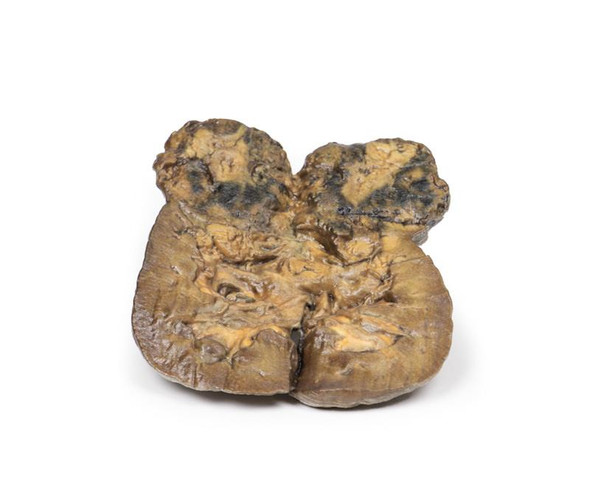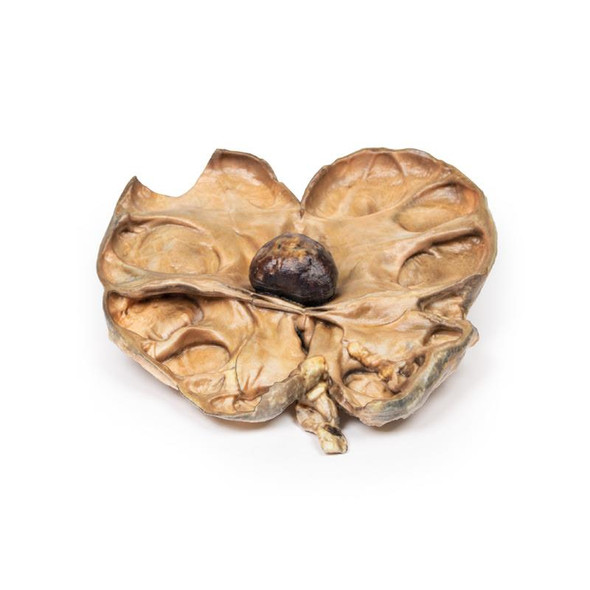Description
Clinical History
A 54 year old male patient presents with flank pain. He is an active intravenous drug user. Further questioning reveals a history of intermittent hematuria, fevers, malaise and vomiting. On examination he is hypertensive and pyrexic. Inspection of his limbs reveals Janeway lesions on his extremities and track marks from recent IV drug use. A systolic murmur is found on auscultation of his chest. Blood tests reveal elevated inflammatory markers, impaired renal function, elevated LDH and multiple bacteremia blood cultures. Echocardiogram shows a large mobile tricuspid vegetation. He was commenced on treatment for infective endocarditis but later died from a sudden cardiac arrest.
Pathology
The specimen is the patient's kidney from post mortem examination. The kidney has been bisected with a cut half surface on display. There are multiple well demarcated wedge shaped pale yellow-white areas evident within the cortex. The base of these pyramids lies against the cortical surface and extend along the renal columns with the apex pointing toward the medulla. The largest is evident lateral upper pole of the kidney. Theses pale areas are infarcted renal tissue. There are dark irregular shaped areas which represent areas of hemorrhage.
Further Information
Renal infarction results from an interruption in the blood flow to the kidney. The kidneys receive almost a quarter of the cardiac output but have limited collateral circulation. The cortex is the most susceptible area to infarction given blood supply is from proximal to distal. The main causes of interruption of this circulation are cardioembolic disease, renal artery damage, hypercoagulable states or idiopathic.
Cardioembolic causes are the most common. These include post-myocardial infarction mural thrombi, septic emboli from infective endocarditis and emboli from mechanical valves. Idiopathic renal infarction is the second most common cause. Damage to the renal artery is the third most frequent cause and includes renal artery dissection, acute vasculitis of polyarteritis nodosa, trauma or post endovascular intervention. Hypercoagulable states are the rarest cause of renal infarcts such as hereditary thrombophilia and antiphospholipid syndrome. Infarction is bilateral in ~15% of cases.
Presentation of renal infarction depends on the underlying etiology. It can be clinically silent. Common manifestations include costovertebral angle pain, hematuria, hypertension due to increased renin release, nausea, vomiting and sometimes fever.
Laboratory test used to aid diagnosis include urinalysis for hematuria and serum creatinine levels which may be elevated, especially in bilateral disease. CT abdomen with contrast is the first choice radiological investigation. A wedge-shaped perfusion defect is the classic finding. Treatment varies depending on the cause of the infarction but generally involves supportive therapy and treatment of the underlying pathology.
Advantages
- Anatomically accurate and identical to real specimen
- No ethical issues - not real human body parts
- Reasonably priced
- Available within a short lead time
- Reproducible, several identical prints can be used as a classroom set
- Can be produced in different sizes to cater for the needs of the teacher
Human Cadavers
- Access to cadavers can be problematic. Many countries cannot access cadavers for cultural and religious reasons
- Cadavers cost a lot money
- High cost for establishing your own plastination suite
- Wet specimens cannot be used in uncertified labs
- Dissection of cadavers is a lot of staff time and that is a cost
- Storage of cadaver material needs special refrigeration etc. which has coast
- If you want another specimen you have to start all over again
Plastinates
- Costs
- Ethical issues
- Timeframe for plastination process
- Many countries do not allow their importation
- One of a kind
Superior 3D print results compared with conventional methods
- Vibrant color offering with 10 million colors
- UV-curable inkjet printing
- High quality 3D printing that can create products that are delicate, extremely precise and incredibly realistic
Clear Support Material
- To avoid breakage of fragile, thin, and delicate arteries, veins or vessels, a clear support material is printed on such spots. This makes the models robust and can be handled by students easily.

















